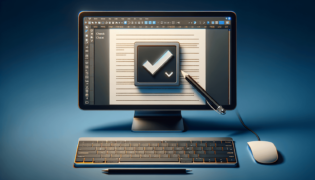
Removing Blank Pages in a Word Document
To remove blank pages from a Word document, the process can vary depending on the cause of the blank page. Below are the general steps to follow:
- Navigate to the end of the document by pressing Ctrl + End on your keyboard.
- Press the Backspace key until the blank page is removed. If the page does not delete, proceed to the next steps.
- Enable paragraph marks by clicking the ¶ symbol in the toolbar or by pressing Ctrl + Shift + 8. This will reveal hidden formatting symbols.
- Locate any page break symbols (a dotted line labeled “Page Break”) and delete them.
- If the blank page persists, it may be due to excessive paragraph breaks. Highlight and delete these as needed.
- Finally, ensure your document’s end paragraph is not set to a page break. Adjust paragraph settings if needed.
Quick summary
- Press Ctrl + End and use the Backspace key to try removing the blank page.
- Enable paragraph marks with Ctrl + Shift + 8 to identify and delete unnecessary page breaks or paragraph breaks.
- Delete page break symbols and excessive paragraph breaks to eliminate blank pages.
- Adjust document’s end paragraph settings if necessary.
At LearnWord.io, we understand that blank pages in a document can disrupt the flow of your content and create an unprofessional appearance. Therefore, addressing this issue effectively is crucial. The following advice delves deeper into understanding and removing blank pages from your Word document, ensuring a polished and reader-friendly document.
Why do Blank Pages Appear?
Blank pages in Word documents can appear for several reasons—ranging from accidental page breaks to hidden formatting marks or text boxes that push content. Understanding these causes helps in effectively tackling the problem.
Detailed Steps for Removing Blank Pages
Removing blank pages might require a bit more attention to detail:
- Viewing Non-Printing Characters: Turning on the display of non-printing characters is crucial. These symbols represent page breaks, paragraphs, and spaces, assisting in identifying unnecessary elements.
- Manual Deletion: Sometimes, a manual approach is best. Clicking on the blank page’s last line and using the Backspace key can often resolve the issue.
- Adjusting Page Setup: Excessive spacing or incorrect page settings can contribute to blank pages. Accessing the Page Setup dialog box (Layout tab > Page Setup group) allows for adjustment of margins, page orientation, and size, potentially resolving the issue without direct deletion.
- Using Section Breaks Wisely: Instead of page breaks, consider using section breaks for more control over document formatting. This can prevent unwanted blank pages.
- Checking for Hidden Tables or Text Boxes: Lastly, invisible tables or text boxes at a document’s end can force a new page. Deleting or adjusting these elements can remove the blank page.
Remember, at LearnWord.io, we’re here to guide you through common Microsoft Word challenges. Removing blank pages might seem daunting, but with our trusted advice, it’s simpler than it appears. Don’t let a few blank pages stand in the way of achieving a professional-looking document. Take action with these tips, and create documents that look exactly how you envisioned.
Final Word
Blank pages in a Word document can be frustrating, but they’re usually easy to fix once you know what to look for. Using this guide, you’re now equipped to tackle this issue head-on, ensuring your documents are concise and professionally presented. Remember, practice makes perfect, so don’t hesitate to revisit these steps whenever you’re faced with this common conundrum. Here at LearnWord.io, we believe in empowering you with the knowledge to solve your document dilemmas with ease.
Featured Posts
- No pillar pages found.








